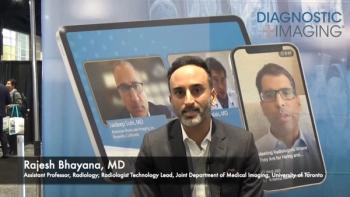
ECR 2021: ABUS as the Right Follow-up to Screening Women with Dense Breasts
For women with dense breasts, automated breast ultrasound offers advantages over supplemental screening with hand-held ultrasound.
When it comes to breast cancer screening for women with dense breasts, automated breast ultrasound (ABUS) is the right choice to supplement mammography, according to industry experts.
During a 2021 European Congress of Radiology (ECR) annual meeting presentation, Athina Vourtsis, M.D., Ph.D., director of the Diagnostic Mammography Center in Athens, Greece, as well as the founding president of the Hellenic Breast Imaging Society, made the case for using ABUS whenever you need additional screening for women who have greater breast density.
For additional ECR 2021 coverage, click
While screening mammography is still considered the gold standard for breast cancer detection, she noted that 50 percent of existing breast cancers are not associated with the micro-calcifications mammography picks up best. That opens the door for the masking effect, leading to a potential rise in interval cancers.
In addition, 43 percent of women between ages 40 and 74 have dense breasts. Not only are they four-to-six times more likely to develop breast cancer, but they also face an 18-times higher risk of an interval cancer. Consequently, Vourtsis said, implementing an effective supplemental screening tool is critical.
Hand-held ultrasound (HHUS) can work well, she said, but it does present challenges. Capturing high-quality images can require rigorous training, and it still depends on operator experience. The field-of-view is also small, and HHUS does have a higher false positive rate.
This is where ABUS comes in, she said. It can be used in diagnostic settings, as a second look after MRI, in pre-operative settings, or it can be used for the correlation of molecular subtypes of breast cancer.
ABUS Benefits
Among several benefits, Vourtsis said, ABUS is operator-independent, offers a larger field-of-view, can complete both batch and double reading, and it can integrate computer aided detection (CAD).
The images produced are superior, as well, she explained, as the tool can convert 2D datasets into multi-planar 3D reconstructed images that give radiologists a more thorough view of the breast. According to existing research, she said, this multi-planar reconstruction offers 96 percent-to-100 percent specificity and 80 percent-to-89 percent sensitivity for breast cancer detection, as well as an improved area under the curve. Additionally, evidence shows that it can downgrade between 3 percent and 18 percent of benign biopsied lesions to BI-RADS 2.
Successful Implementation
There are three aspects to successful ABUS implementation, Vourtsis said, with the technologist, patient, and radiologist all playing significant roles.
Technologist: The technologist is responsible for appropriately positioning the patient and applying enough lotion to the entire breast prior to imaging. Adequate depth and compression, as well as proper transducer positioning are vital to getting the best images. Following these steps will result in optimal image capture that can do a better job of detecting smaller breast cancers that are behind the nipple, near the chest wall, or in the periphery of the breast. It can also decrease the false positive rate and improve the positive predictive value of the biopsies performed.
Patient: Instruct each patient to continue to breath normally, but to avoid speaking or coughing during the imaging process. They should also remain still and not try to change positions between each image acquisition.
Radiologist: In order to decrease the false positive rate, providers must capture precise information from the patient’s history. Be sure to read all volumes and planes, she recommended, and in the radiology report, use BI-RADS structured reporting and record all findings. You should also read both ABUS and mammography images for the most complete assessment.
Artifacts
Radiologists also need proper training and education in order to be able to identify the artifacts that can occur with ABUS, Vourtsis stressed.
There are four main types of artifacts you can encounter:
- Technical: Caused by improper positioning, lack of contact, or skin folds.
- Software: A result of nipple artifact or silhouette.
- Physiologic: Caused by cardiac activity or motion.
- Lesion-related: A result of skip, enhancement, or shadowing.
There are ways to avoid these artifacts, however, she said:
- Use additional planes to analyze peripheral abnormalities and artifacts.
- Use a second view to resolve shadowing as a one-view-only artifact.
- Use the rotational software to interpret shadowing.
Even with all these benefits and capabilities, Vourtsis said, work is still ongoing to continue to improve ABUS. Research is currently underway to see how implementing CAD could drive down the recall rate associated with the screening method while improving the detection of suspicious lesions.
For more coverage based on industry expert insights and research, subscribe to the Diagnostic Imaging e-Newsletter
Newsletter
Stay at the forefront of radiology with the Diagnostic Imaging newsletter, delivering the latest news, clinical insights, and imaging advancements for today’s radiologists.




























